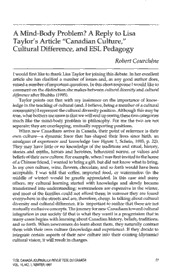
ERIC EJ558284: A Mind-Body Problem? A Reply to Lisa Taylor's Article "Canadian Culture," Cultural Difference and ESL Pedagogy. PDF
Preview ERIC EJ558284: A Mind-Body Problem? A Reply to Lisa Taylor's Article "Canadian Culture," Cultural Difference and ESL Pedagogy.
A Mind-Body Problem? A Reply to Lisa Taylor's Article "Canadian Culture," Cultural Difference, and ESL Pedagogy Robert Courchene IwouldfirstliketothankLisaTaylorforjoiningthis debate. Inherexcellent article she has clarified a number of issues and, as any good author does, raisedanumberofimportantquestions.InthisshortresponseIwouldliketo commentonthedistinctionshemakesbetweenculturaldiversityand cultural differenceafterBhabha(1995). Taylor points out that with my insistence on the importance of know ledgeintheteachingofcultural(and,Ibelieve,beingamemberofacultural community)Irepresenttheculturaldiversityposition.Althoughthismaybe true,whatbothersmemoreisthatwewillendupseeingthesetwocategories much like the mind-body problem in philosophy. For me the two are not separate;theyareoverlapping,mutuallysupportingpositions. When new Canadians arrive in Canada, their point ofreference is their own culture---a dynamic force that has shaped their lives since birth, an amalgam of experience and knowledge (see Figure I, Schein, 1985, p. 22). They may have little or no knowledge of the traditions and ritual, history, stories and myths, heroes and heroines, behavioral norms, or values and beliefsoftheirnewculture.Forexample,whenIwasfirstinvitedtothehome ofaChinesefriend, Iwantedtobringagift,butdidnotknowwhattobring. In myownculture,wine,flowers, chocolate, and so forth would have been acceptable. I was told that coffee, imported food, or watermelon (in the middle of winter) would be greatly appreciated. In this case and many others, my cultural learning started with knowledge and slowly became transformed into understanding: watermelons are expensive in the winter, and most ofthe families could not afford them; in summer they are found everywhereinthestreetsandare,therefore,cheap. Intalkingaboutcultural diversityand culturaldifference,itis importantto realize thatthesearenot mutuallyexclusiveconcepts.ThejourneyfornewCanadianstowardcultural integrationinour society (ifthat is what theywant) isa progressionthat in manycasesbeginswithlearningaboutCanadianhistory,beliefs,traditions, andsoforth. Whennewcomersdolearnaboutthem, theynaturallycontrast them with their own culture (knowledge and experience). Ifthey decide to integrate certain aspects of their new culture into their existing (dynamic) culturalvision,itwillresultinchanges. TESLCANADAJOURNAULAREVUETESLDUCANADA 77 VOL.15,NO.1,WINTER1997 1. Artifactsand Creations Technology Visible butoften Art not dcciphcrablc Visibleand audible bt'bavior pallerns 2. Values Grcatc)"levcl of Testablc in thc physical'cnvironmcnt awareness Testableonly bysocialconscnsus 3. BasicAssumptions Relationship to environmcnt Takcn for grantcd, Natureofreality, time, and spacc Invisiblc, Natureofhuman naturc Prcconscious Natureofhuman activity Natureofhuman relationships Figure1.Thelevelsofculture. Ifone looks at Schein's (1985) visual display of different aspects of cul ture,itisevidentthatjusttellingpeopleaboutbasicassumptionsthatunder lie Canadian society will not enable them to internalize them; that is, our relationship toward nature or our concept of time. These values cannotbe taughtthe sameway thenames ofprimeministers ofCanada can. In many cases teachers would have great difficulty in even describing them; such values must be lived and experienced in context; teachers may be able, however, to create situations inside and outside class to place students in situationsthatwillallowthemtogainsomeinsightintowhatmakesCanadi ans tick. Trying to teachCanadian culture at this level, therefore, is the real challenge,astraditionaltransmissionmethodsdonotwork. In talking about the relationship between knowledge and experience, about culture as an "epistemological object" and culture as coming to be "knowableandknownandwhatrelationstheyestablishbetweenknowers" (Bhabha,1995,pp.206-207),onemustdistinguishbetweentheentrylevelof cultural experience and a more fully developed cultural experience. Al though the door leading in may be knowledge, the road that leads to real cultural understanding is certainly that of experience. However, it often happens thatas peoplebecome detachedfrom their culture,thatis,theyno longer have experiential knowledge, they do things on the basis of know ledgeortraditionwithoutreallyknowingwhytheyaredoingit.Therelation between the two, therefore, is often complex. At a Pow-Wow to celebrate Aboriginal culture, I overheard two young people talking. One asked why thesweetgrassceremonyiscarriedoutatthebeginningofcertainevents.The 78 ROBERTCOURCHENE otheranswered,"Idon'tknow;somethingabouttheearthisallIremember mygrandfathertellingme."Hewenton,however,toexplainindetailhowit wasdone. Here we have a case ofmemorywithout theunderlyingcultural valuesandbeliefs. InothercasesnewCanadiansoftenacquireexperientialknowledge(often through episodic learning) without at the same time knowing why what happenedhappened,forexample,peoplewhowereyelledatforcuttinginto lines,whoaretolditisnotpolitetoswear(nativespeakersaccordthemselves thisprivilege),orwhoareconstantlyrefusedjobsorapartments.Whenthey aretoldaboutcertainculturaltraditionsorpowerrelationships,theycometo understand, although they do not necessarily accept or agree with what happened. In summary, knowledge and experience are intertwined parts of any dynamic culture. At different times in an individual's personaljourney to wardincreased culturalunderstandingorculturalintegration, oneorother of the two components may play an important role. Furthermore, some aspects ofcultureareeasiertopresentina didactic manner,whereasothers mustbeexperiencedtobeunderstood.Ourchallengeasteachersistosetup learning environments both inside and outside of the classroom that will enable new Canadians to experience all aspects of our culture so they can arriveatanewculturaldynamicthatwillallowthemtofunctioncomfortab ly(culturallyspeaking)inoursociety. References Bhabha,H.(1995).Culturaldiversityandculturaldifferences.InB.Ashcroft,G.Griffiths,&H. Tiffin(Eds.),Thepost-colonialstudiesreader(pp.206-211).London:Routledge. Schein,E.(1985).Howcultureforms,developsandchanges.InR.Kilman,M.Saxton,R.Serpa, &Associates(Eds.),Gainingcontrolofthecorporateculture(pp.17-43).SanFrancisco,CA: Jossey-Bass. Editor's Note BothRobertCourcheneandVirginiaSauvewereinvitedtorespondtoLisaTaylor'sarticle.Dr. Sauveregretsthatshewasunabletodoso,forreasonsnotassociatedwiththearticle. TESLCANADAJOURNAULAREVUETESLDUCANADA 79 VOL.15,NO.1,WINTER1997
